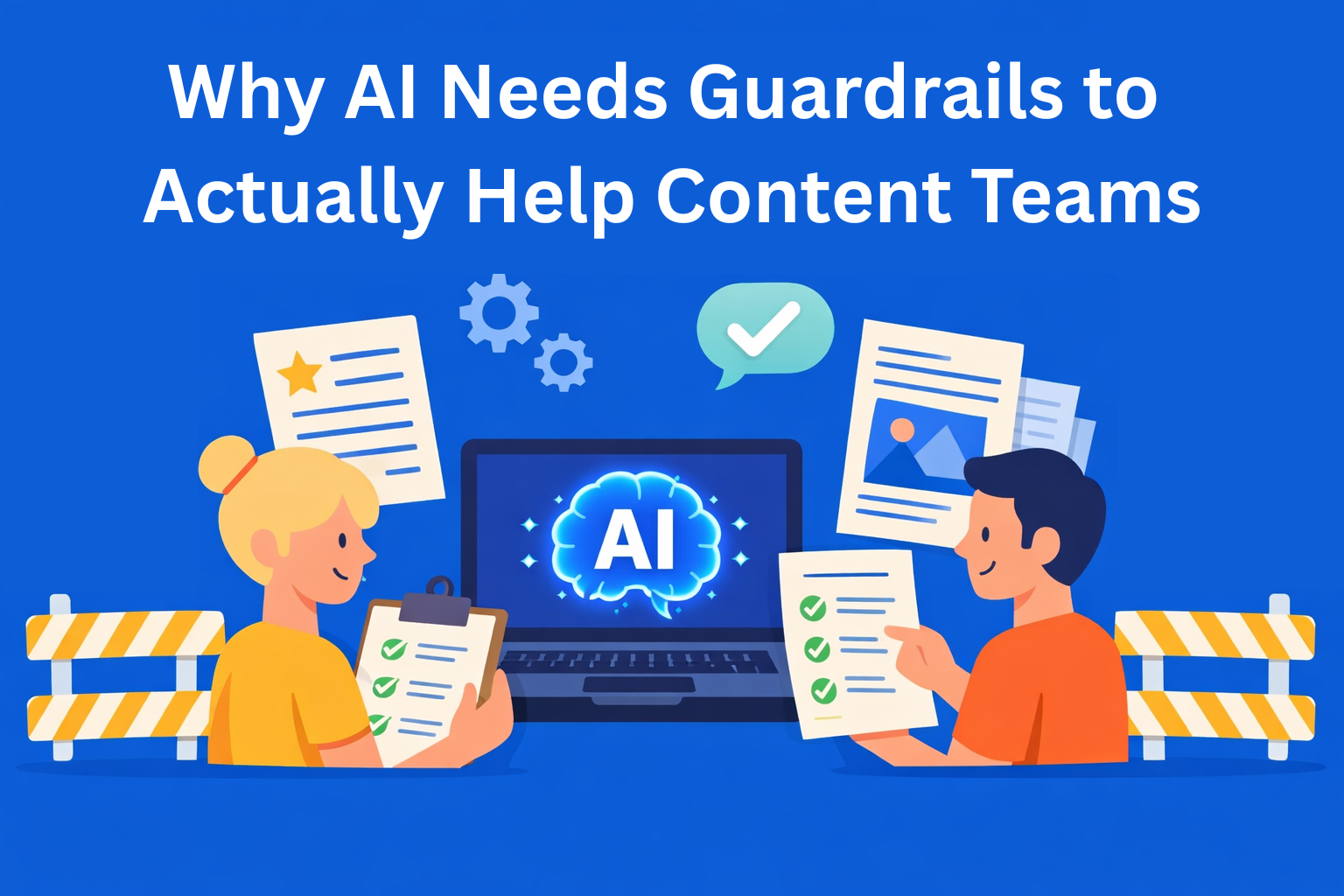Key Must-Have Features for a Future-Proof Content Management System in 2025
Discover the must-have features of a future-proof CMS in 2025 from AI assistance and automation to omnichannel publishing and advanced security. Learn how platforms like EasyContent help teams work faster, smarter, and stress-free in an ever-evolving digital landscape.
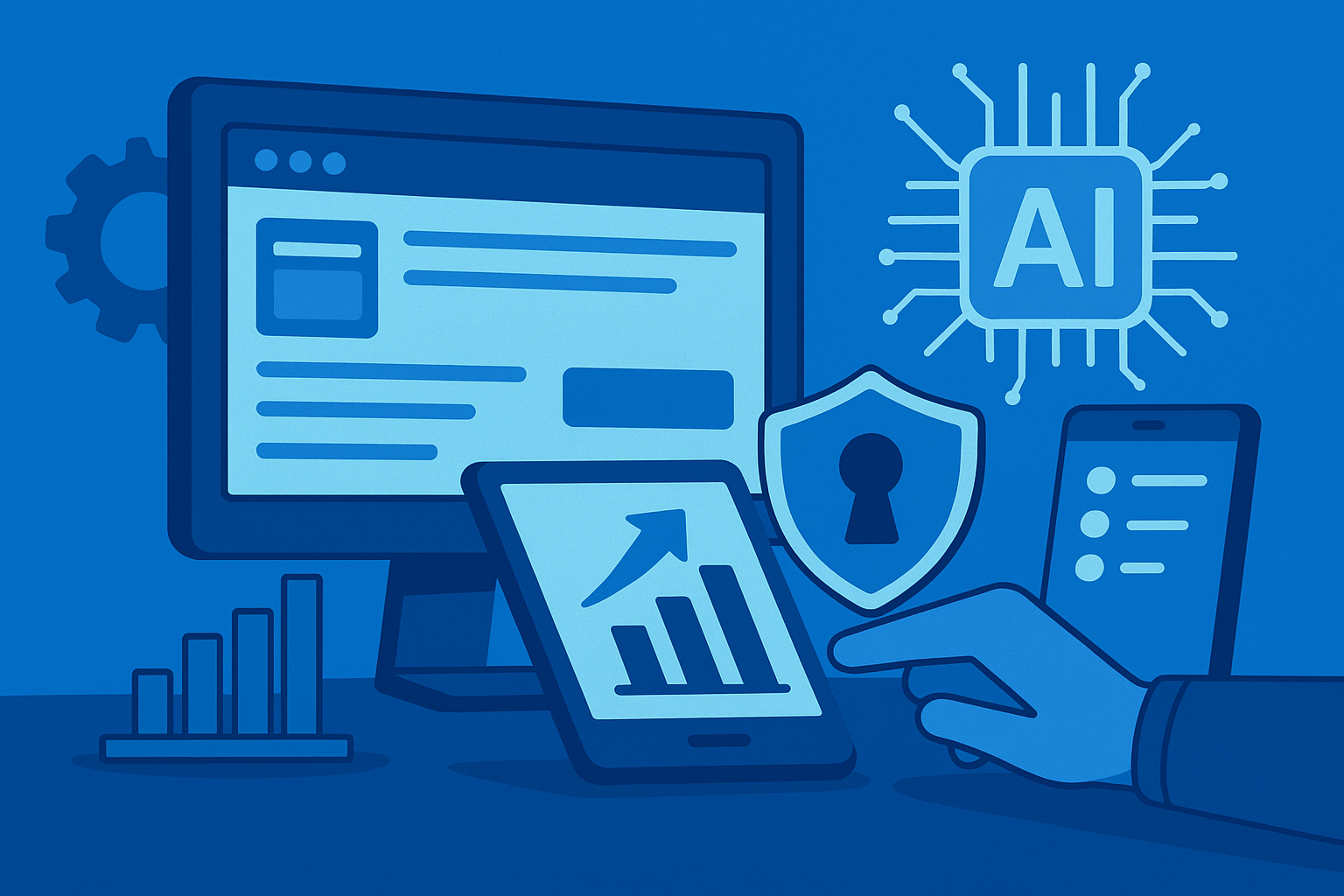
From basic text editing and publication, content management has progressed greatly. Companies require a content management system (CMS) that meets the shifting needs of the sector as digital environments get more competitive. A future-proof CMS is now a necessity, not just a luxury. Businesses that wish to stay ahead must embrace scalable, automated, omnichannel publishing systems to satisfy rising expectations.
Simply won't cut it anymore the conventional approach of managing content—manual approvals, multi-platform publishing, and fighting with version control. Teams are producing more than ever, and companies risk falling behind without systems designed to expedite workflows. A modern CMS must handle everything from AI-driven content recommendations to real-time collaboration, while ensuring security and efficiency.
One of the primary shifts in content management is the demand for seamless integration across multiple channels. Websites, social media, email marketing, mobile apps—all need platform-agnostic content. Here, a scalable and flexible CMS becomes crucial. Businesses relying on outdated tech will struggle to deliver dynamic, engaging content.
Another game-changing factor is automation. What once required manual approvals, updates, and scheduling, can now be automated to save time and reduce human error. Tools like EasyContent empower editorial and marketing teams with streamlined content production. Without switching between apps, teams can collaborate, track progress, and manage the entire content lifecycle efficiently.
Looking forward, the best CMS solutions will offer not just organization, but also advanced analytics, personalization, and AI-powered insights to help businesses optimize their strategies. The goal of a future-ready CMS is to bring simplicity to content creation—not complexity. Its foundation lies in flexibility, efficiency, and the scalable delivery of personalized content experiences.
This blog explores the key features every company should seek in a next-gen content management system. From automation and security to omnichannel publishing and performance analytics, these are the tools that will help businesses stay ahead in an ever-evolving digital landscape.
AI-Powered Content Assistance
Making content goes beyond just sitting down and writing nowadays. As AI-powered content rises in popularity, businesses can simplify their processes, ensure quality, and create content that’s optimized for engagement. AI brings smart suggestions, predictive insights, and automated formatting that change how content is produced and managed.
One of the most impactful uses of AI in content creation is real-time recommendations. It helps with sentence structure, SEO optimization, and tone, making sure content speaks to the right audience and stays consistent. AI also automates formatting tasks like applying templates, adjusting headings, and organizing bullet points—saving time and reducing errors for teams managing large volumes of content.
A key benefit is AI’s ability to analyze past performance and suggest topics, formats, and even best times to publish, so teams can stay ahead of trends and audience expectations. Another game-changer is AI-driven personalization. Instead of generic content, brands can now deliver tailored experiences based on user behavior, boosting engagement and conversion.
Platforms like EasyContent support this shift—not by generating AI content, but by offering a space where AI insights can be applied inside a structured, collaborative system. Teams stay in control while still reaping the benefits of AI speed and accuracy. As AI continues to evolve, businesses that use it smartly—for better decisions, faster production, and deeper personalization—will stay competitive and more connected with their audience.
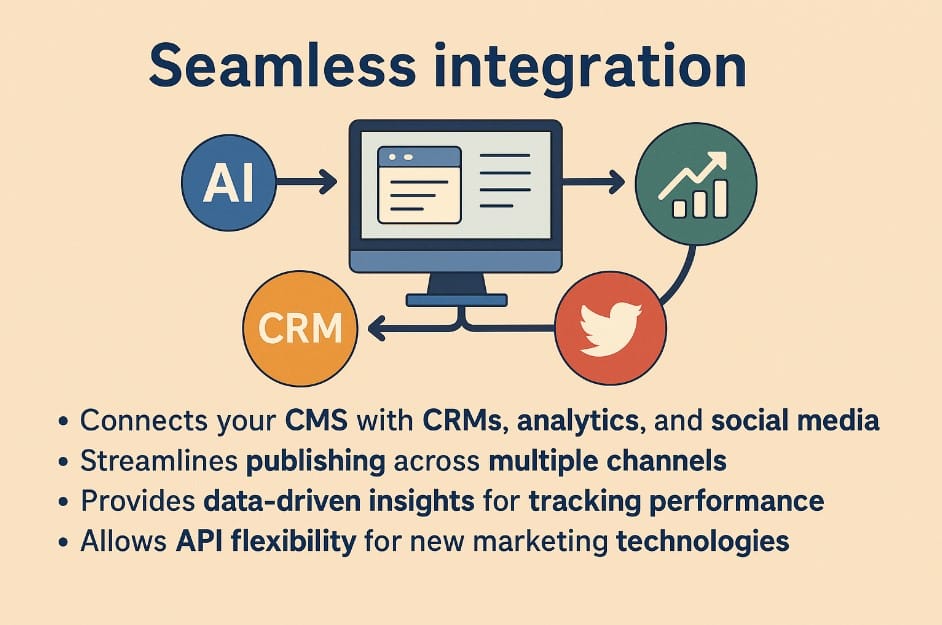
Seamless Integration with Other Marketing Tools
Content management is not only about producing and distributing for modern marketing teams; it also guarantees a flawless connection between several technologies driving campaigns ahead. A future-proof CMS has to interact naturally with CRMs, analytics tools, social media management systems, and other core marketing platforms. Businesses run the danger of working in silos without these linkages, which slows down processes and complicates performance measurement.
Content dissemination can be greatly streamlined thanks to a CMS that links with other solutions. Teams may automatically publish straight from their CMS to social media, email tools, or websites, instead of manually copying and pasting content. This helps to save time and ensures content reaches the right audience at the right moment. Integration with scheduling tools helps marketers maintain a consistent publishing schedule without constant manual effort.
Beyond distribution, effective performance tracking depends heavily on seamless integration. When a CMS connects to analytics tools, marketers can immediately track performance across multiple channels. Key metrics like audience demographics, conversion rates, and engagement levels become instantly available, allowing teams to adjust strategies in real time. These data-driven insights help maximize ROI and refine content plans based on actual results—not assumptions.
API flexibility is another critical piece in ensuring a CMS can keep up with emerging technologies. Since the digital landscape is constantly evolving, businesses need a CMS that can connect with new tools without needing a full system overhaul. A CMS with open APIs empowers teams to scale, integrate, and adapt workflows as needs evolve—keeping them ahead of the curve and out of tech dead-ends.
EasyContent understands how essential this kind of integration is for today’s content teams. While it’s not an AI tool itself, EasyContent offers a structured platform that boosts team collaboration and workflow efficiency. By syncing with other marketing systems, it enables teams to manage content, approvals, and performance in one place—reducing friction and allowing teams to focus on building stronger campaigns instead of juggling disconnected tools.
Seamless integration is no longer a “nice to have”—it’s a must-have. Teams using a CMS that integrates with CRMs, analytics platforms, and social media tools will work smarter, automate repetitive tasks, and make decisions based on real-time data. A flexible, connected solution like EasyContent can make all the difference in staying competitive and producing content that truly performs.
Adaptive and Omnichannel Publishing Capabilities
Modern content marketing goes beyond simply posting a blog entry or article on a website. Audiences nowadays consume material on several platforms—social media, email, mobile apps, smart gadgets, even voice search. Companies require a content management system that lets them produce material once and easily distribute it over all these outlets without additional work. Here is where adaptable and omnichannel publishing features become really vital.
Instead of manually adjusting material for multiple formats, a modern CMS should be able to dynamically update it. Whether it's translating a long-form blog into bite-sized social media updates or optimizing content for desktop and mobile, a future-proof system guarantees material stays engaging and accessible across every touchpoint. Consistency across platforms improves brand image and saves time.
Headless CMS solutions have been gaining popularity due to their flexibility. Unlike traditional CMS platforms, a headless CMS allows content to be stored centrally and delivered to various platforms via APIs. This makes it easy to push updates to multiple channels—websites, apps, smart assistants, or even AR interfaces—all from a single source. As content formats evolve, no full system overhaul is needed.
Companies must also consider how content is consumed beyond screens, with the rise of voice search and interactive media. A strong CMS should offer structured content that can be optimized for smart speakers. Features like quizzes, polls, or embedded videos must also be seamlessly managed and published, enabling rich user experiences.
EasyContent provides marketing teams with the ability to structure and organize content for easy multichannel distribution. While not an AI tool, it acts as a productivity-boosting platform, helping teams work smarter and maintain consistency across platforms.
Companies that want to stay competitive must have systems that adapt to evolving audience behavior. Whether it’s social, mobile, or smart tech, a CMS that supports omnichannel publishing ensures content reaches the right audience in the right way. A scalable, flexible CMS like EasyContent helps future-proof your content while boosting team efficiency.
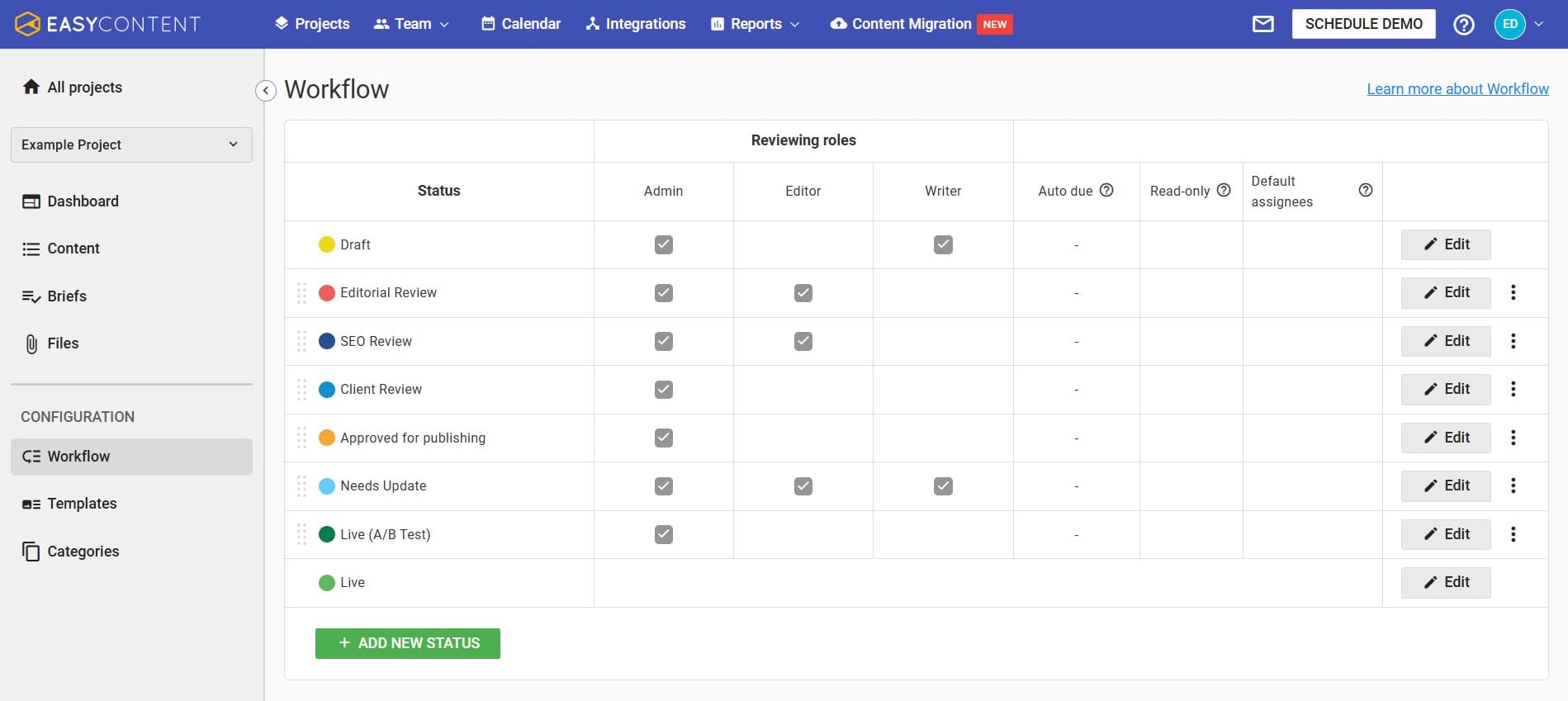
Automated Content Workflows for Faster Production
Managed without technology, content production can be disorganizing. Teams have to track projects, wait for approvals, and handle never-ending back-and-forth correspondence. This slows down the process and causes unnecessary delays. Businesses that want to stay competitive need a solid system to keep everything moving and support content growth.
Automated systems help to remove obstacles, which is one of their biggest advantages. Automation ensures that content flows naturally from one step to the next, without manually assigning tasks or chasing approvals. Once a writer submits a draft, the system automatically notifies the editor. When approved, the content moves on without delay—saving time lost on follow-ups.
Task automation also plays a key role in boosting productivity. Clear workflows help teams to assign roles instantly—managers approve, writers draft, editors review. Everyone knows exactly what to do and when, which eliminates confusion and last-minute stress around deadlines.
Real-time alerts keep everyone in the loop, improving overall flow. If something’s due or waiting for action, the system sends out automated reminders so that nothing falls through the cracks. This reduces constant emails and meetings, allowing teams to focus on creating content, not chasing updates.
Access control is another critical piece. Not everyone needs full access. With role-based permissions, only the right people can edit, approve, or publish. This keeps the process safe, organized, and reduces the risk of accidental changes.
EasyContent helps marketing teams implement all these automation features. While it’s not an AI tool, it’s built to boost team performance by streamlining content workflows and eliminating delays. With structured approvals, real-time alerts, and automated assignments, teams can focus on quality content, not micromanagement.
Workflow automation isn’t just about speed—it’s about producing better content with less stress. Companies that adopt it meet deadlines and deliver better results with less effort.
Advanced Security and Compliance Features
Businesses need data security and compliance more than anything else, hence they have to choose a content management system with advanced security tools. Apart from basic account protection, a future-proof CMS should have strong mechanisms to safeguard private information and ensure compliance with global data standards.
Among the main aspects of security is data protection. Companies handling large volumes of internal and client data must ensure compliance with GDPR, CCPA, and similar privacy laws. A secure CMS should include encryption for data both in transit and at rest, minimizing the risk of leaks or unauthorized access.
Role-based permissions offer another layer of protection by allowing only authorized users to access specific content. Instead of giving everyone the same access, a structured permission system enables businesses to define clear roles—writers, editors, and managers—each with different levels of control. This prevents accidental changes and preserves content integrity.
Maintaining brand consistency means preventing unauthorized edits to key materials. A CMS with audit logs and version control allows teams to track who made changes and revert to previous versions when needed. This level of transparency reduces mistakes and gives companies full control over their content.
EasyContent ensures that only the right people can access, edit, or approve content, providing marketing teams with a secure and reliable workspace. While it’s not an AI tool, it helps boost productivity by creating a safe environment for collaboration—free of security worries or unauthorized changes.
Companies cannot afford to ignore content security in today’s landscape of evolving cyber threats. Any organization handling digital assets needs a secure CMS. Prioritizing modern security measures and compliance features helps protect sensitive data, meet regulatory requirements, and keep content safe at every stage of production.
Scalability and Performance Optimization
Companies expand with their content needs as well. Designed for scalability, a content management system must be able to manage expanding amounts of data, users, and procedures without slowing down. Without a scalable CMS, growing businesses face the risk of content publishing delays, disconnected systems, and performance issues.
Infrastructure housed on clouds is one of the main determinants of scalability. Operating on a cloud platform, a CMS lets teams access materials from anywhere and guarantees consistent performance. Cloud-based systems lower downtime and increase accessibility unlike conventional systems struggling with large databases or heavy traffic.
Just as vital as scalability is performance improvement. A slow CMS causes workflow inefficiencies, frustrates content teams, and ultimately reduces audience engagement. Content caching and optimization ensure that media-rich content and high-traffic pages load quickly without sacrificing quality. A system that intelligently manages delivery improves website performance and reduces server load.
For marketing teams and content creators, EasyContent provides a structured and organized space where workflows remain seamless, no matter how much content is being managed. Teams can rely on a centralized system that scales with their needs rather than juggling disconnected platforms. From planning to approval, automation and role-based management ensure that initiatives remain efficient as they grow.
Long-term success hinges on choosing a CMS that grows with your business. Maximizing scalability and performance boosts content growth and improves team efficiency. Investing in a future-proof CMS ensures streamlined processes, stronger teamwork, and timely delivery—no matter how large the content load gets.
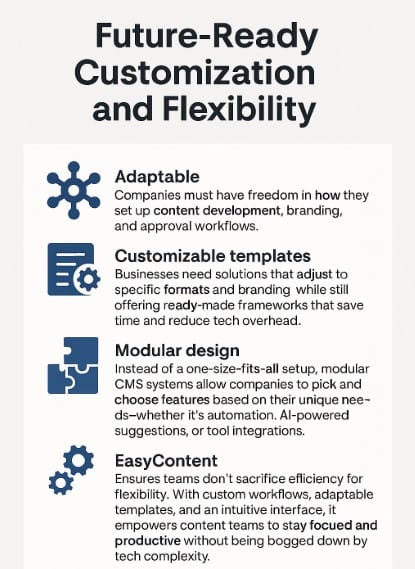
Future-Ready Customization and Flexibility
Content management systems that are future-ready must be adaptable to fit evolving organizational needs. Companies must have freedom in how they set up their content development, branding, and approval workflows. While a flexible platform enables better customization, a rigid CMS can slow down operations.
One of the key advantages of a flexible CMS is the ability to use customizable templates. Businesses need solutions that adjust to specific formats and branding, while still offering ready-made frameworks that save time and reduce tech overhead.
Another important element is modular design. Instead of a one-size-fits-all setup, modular CMS systems allow companies to pick and choose features based on their unique needs—whether it’s automation, AI-powered suggestions, or tool integrations.
When choosing between an open-source and a proprietary CMS, companies must balance control and ease of use. Open-source offers maximum flexibility but often requires advanced technical skills. Proprietary systems are more user-friendly and supported, but may have limited customization. The ideal CMS offers a mix of both: usability with room for tailoring.
EasyContent ensures teams don’t sacrifice efficiency for flexibility. With custom workflows, adaptable templates, and an intuitive interface, it empowers content teams to stay focused and productive without being bogged down by tech complexity.
As content needs evolve, a CMS must evolve too. Customization and flexibility are no longer nice-to-haves—they’re essential for companies that want to stay agile, grow seamlessly, and keep content well-structured and aligned with their brand.
Choosing the Right CMS: The Key to Staying Ahead in the Evolving Digital Landscape
A future-proof content management system serves purposes beyond only providing digital asset storage. It should be flexible, safe, and effective so companies may grow without needless obstacles. Features like artificial intelligence-powered automation, smooth integrations, omnichannel publishing, and superior security guarantee that content teams can meet rising needs while preserving high-quality output.
First priority should be investing in a CMS that provides automation to help companies clear workflow bottlenecks, cut duplicated operations, and simplify approvals. Security and compliance are equally important since they guarantee that private data stays private while keeping role-based access limitations. Scalability is another key factor; companies want a system that grows with them instead of one that gets outdated as content demand increases.
EasyContent provides companies trying to maximize their content management with a complete solution. By centralizing processes, automating content approvals, and streamlining team operations, teams running smarter than others can be attained. Content teams can focus on what actually counts—creating outstanding material that gets results—instead of juggling many tools and fighting inefficiencies.
As content tactics evolve, a CMS that can adapt with the times becomes rather essential rather than optional. Companies who make investments in an automated, scalable, safe platform will lead in the digital landscape.




